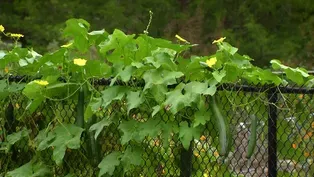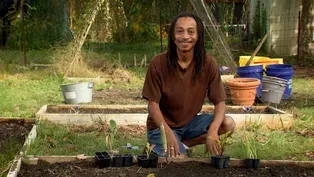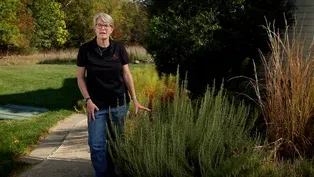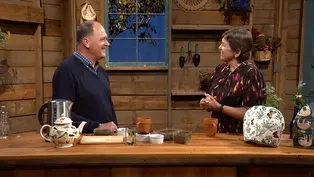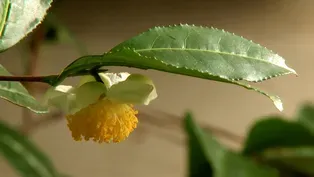Virginia Home Grown
Luffa Garden
Clip: Season 23 Episode 8 | 7m 34sVideo has Closed Captions
Discover how luffa plants are grown to make natural sponges!
Amyrose Foll meets Lara Brooks of Lara’s Luffa to learn about growing luffa to produce natural sponges. Featured on VHG episode 2308; October 2023.
Problems with Closed Captions? Closed Captioning Feedback
Problems with Closed Captions? Closed Captioning Feedback
Virginia Home Grown is a local public television program presented by VPM
Virginia Home Grown
Luffa Garden
Clip: Season 23 Episode 8 | 7m 34sVideo has Closed Captions
Amyrose Foll meets Lara Brooks of Lara’s Luffa to learn about growing luffa to produce natural sponges. Featured on VHG episode 2308; October 2023.
Problems with Closed Captions? Closed Captioning Feedback
How to Watch Virginia Home Grown
Virginia Home Grown is available to stream on pbs.org and the free PBS App, available on iPhone, Apple TV, Android TV, Android smartphones, Amazon Fire TV, Amazon Fire Tablet, Roku, Samsung Smart TV, and Vizio.
Providing Support for PBS.org
Learn Moreabout PBS online sponsorship>>So the luffa comes from the gourd family.
And it's originally from Southeast Asia, so it's kind of more tropical, but you can grow it through zone 7.
>>Very nice, what do you do with these?
I've never met anyone that grows luffa before.
>>Right, so luffa is kind of dual-purpose.
So, when it's very, very, very small, just like this one, it is edible.
But most people grow luffa because it creates a natural sponge.
This vine will grow 120 days, and after 120 days, you can harvest the fruit.
And after you harvest the fruit, then you can take off the skin, extract all the meat and seeds, and you're left with this internal xylem.
And that fiber can be dried out and used as a natural sponge, which is great because then it's compostable, and so less plastics.
And you can use it for anything really.
>>How long do they last?
>>The sponge itself can last up to a year, so as long as it dries out between uses.
Originally, I started off because I wanted to block an old fence and I was just looking for a pollinator.
Because not only does this plant do that visual barrier, which is a beautiful visual barrier, but it has these gorgeous, gorgeous yellow flowers.
And bees and wasps and ants and, you know, moss and butterflies, they're all over it all summer long.
So it has that potential too.
But they're also great, especially here in Virginia, is because they're deer-resistant.
Oh, so the deer don't bother them at all.
But you also have to think, what are you gonna do with all this luffa when you're all done?
You'll have enough sponges for the rest of your life for every kind of purpose that you would ever need.
>>That's a really interesting farm business.
And you're doing it here.
>>Yeah.
>>Right next to your house.
>>Yeah, just on, you know, this suburban lot.
>>So, when you're getting these ready for the market, are you selling the whole sponge or are you portioning them off?
>>So, I can sell them whole but they're very hard to process whole.
So normally, I sell them in five to six inches.
So it's good enough for you to hold in your hand.
>>Is this a difficult plant to grow?
>>It is not difficult in the fact that once it's growing, it just grows and grows and grows up to 30 feet.
But it is kind of hard to get it started because the seeds are hard to germinate.
It has to be started early, so that's another thing.
So you have to be ready to go.
So you have to have your site kind of decided where exactly where you want it 'cause as you can tell, that 30 feet of vines can just take over everything.
And it needs that full sun.
So, you have to kind of think about it first.
And then once you plant it, usually if you're doing a direct sow, three weeks before the last frost, and then it takes 20 days to germinate.
So you're waiting and waiting and waiting for that germination.
And then finally, the plant is germinated, starting to grow, and then another 90 days before the first fruit.
So you have to be patient with this plant.
It takes a long time to grow, but as you can tell, at the end, you can have a ton to harvest.
>>It is gorgeous.
Can you tell us a little bit about how you harvest and when to harvest.
How you know it's ready?
>>Yeah, so that's the trick with luffa because if you actually harvest it too soon, the xylem inside, 'cause it has a fiber inside, so it's a gourd.
So think about a pumpkin, it has like that pumpkin meat and seeds in it.
But it also has this internal fiber in it.
So, if you harvest it too soon, the fiber hasn't developed yet.
So it's a little tricky.
You can wait until it's completely dead on the vine, just brown and dead on the vine.
You can actually shake it and hear the seeds in there.
But if you do that, when you peel it, it's also brown and brittle and you might have to bleach it in order to get that internal sponge.
>>Okay.
>>So that's not a really great product though.
So you have to kind of play around of when you wanna then harvest.
You can harvest when the vine, it gets a little bit brown, and then the gourd itself is still green.
So you can harvest it then.
Or you can do it a little bit beforehand, which is a lot more labor-intensive but you get an amazing product.
And so, you're looking for that skin right before it pulls away from the xylem.
And then, so you can still peel it, but you're actually extracting all the meat and seeds from it.
And from doing that, then you can have that internal fiber.
>>Is it difficult to peel when you take those off when they're not quite brown?
>>They are very difficult to peel.
You actually have to, you know, stratify it and kind of pull it off.
So it is labor-intensive.
It takes about, you know, 10, 15 minutes per fruit in order to do it.
You can see some here.
Like, this luffa right here is probably, you know, a little bit too far gone.
You can see it's brown, it peels off right away.
And you can harvest that.
But if you just wait a little bit longer, or a little bit earlier, and you put in the effort, you can harvest it when it's this lighter color.
And again, I can't really pull the skin off very well right now, but you get a much stronger end product.
But luffa is actually quite interesting too because, and you have to think about this when you're growing it, is that it's a water hog.
I mean, it takes a ton of water.
So when I first started growing it a few years ago, I didn't water it enough, and you just get a few tiny little luffa on it.
So you have to kind of experiment around exactly how you're going to water it, if you have an irrigation system.
But I kind of do the flood method.
So this year I did something new and I put tree rings, and I embedded the tree rings directly into the soil and kind of pushed them in so there was a barrier there.
And then planted the luffa seeds right into those tree rings, so they had, you know, the organic matter they put in there and I usually fertilize with the duck water from the duck pond, you know, as a natural fertilizer.
But that water allows me to water every two to three days and I can flood it.
So the tree ring will hold a few gallons of water and I can just flood it in and it can do a slow drip down.
>>That is an amazing idea.
It's really beautiful.
>>It's the first year I've done that, and I think because of that and because of the trellis, I'm getting a bigger yield this year than previously.
>>There's hundreds of luffa here, it's pretty impressive.
So do you save your seeds from the ones that have gone a little bit too far to use for subsequent plantings?
>>Yes, so every one of these luffa plants, after you extract all the meat, you'll have hundreds of seeds.
So the interesting thing about luffa seeds though is that they don't have a really good germination rate.
So out of those a hundred seeds, maybe only 10 will germinate.
>>Really?
>>So I dry them.
You have to nick the seed, soak the seed for at least 24 hours before you plant them.
And then you have to kind of decide how you're going to plant them.
Are you going to direct sow them or you going to start them so you have a seedling that you can then plant.
And I've done it both ways.
And really, it doesn't really matter.
You kind of get the same results both ways.
Of course, if you do a seedling, then at least you know that that's seed actually.
But when I plant them, I actually overseed.
So you know how when you normally plant something- >>Yes, I do that too.
>>You do like one or two or three seeds.
Like, I am like putting in like, you know, 12 seeds.
So maybe I get three plants out of those 12 seeds.
>>Do you thin them at all?
>>You know what, I have not, because again, not very many of them go to germination.
So it's like you're waiting and waiting and waiting.
Like, are you doing anything, are you doing anything?
And finally, you know, finally, you get the tiny little leaves up.
>>This is amazing.
Thank you so much for sharing your knowledge with us.
>>My pleasure.
Video has Closed Captions
Learn how to grow tea trees and luffa plants! (26m 46s)
Video has Closed Captions
Add interest to landscape beds by using herbs (2m 44s)
Natural Sponges made from Luffa
Video has Closed Captions
Learn how the luffa plant is processed to make a sponge (6m 34s)
Providing Support for PBS.org
Learn Moreabout PBS online sponsorshipSupport for PBS provided by:
Virginia Home Grown is a local public television program presented by VPM
